What is Bonding?
Bonding, also known as bonded restoration, is a painless way to make minor repairs to teeth. In most cases, several teeth can be bonded in one dental visit. Bonding uses tooth-coloured material, called composite resin. Composite resin is put on the tooth, then shaped and hardened with light. The composite resin can be:
- Matched to your
- Shaped to look like the missing part of a chipped
- Used to build up teeth and fill between
- Used on a broken tooth to restore it to
- Painted over a stained tooth to make it match the colour of your other teeth
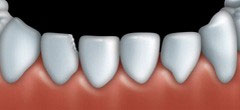
Dental bonding can be used to fix teeth
that are chipped.
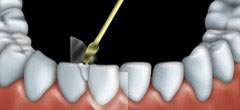
A clear plastic is placed between the tooth being
treated and its neighbouring tooth. Composite
resin is put on the tooth in layers.
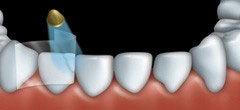
Each layer of the composite resin is shaped
and then hardened with a light.
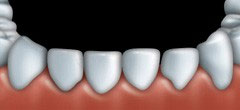
What are Veneers?
Veneers are very thin shells that are attached to the front part of teeth. They are often made of porcelain or composite resin. Porcelain veneers are stronger than composite resin veneers and do not change colour or stain. Generally, porcelain veneers take at least 2 dental visits to apply and composite resin veneers can be done in 1 visit. Porcelain veneers generally last longer than composite resin veneers.
How composite resin veneers are done
Much like bonding, your dentist puts a mild chemical on the front surface of the tooth to be veneered to make it a little rough. This helps the composite resin to stick to the enamel of the tooth. The composite resin that matches the colour of your natural teeth is chosen so that the veneer blends in with your teeth. Your dentist then puts the composite resin on your tooth in layers. A bright light is used to harden each layer of the composite resin. After the last layer of composite resin is hardened, your dentist shapes and polishes it to form your tooth. The finished tooth looks natural and smooth.
How porcelain veneers are done
With porcelain veneers, your dentist may give you a local anesthetic (freezing). Your dentist then removes a thin layer of the enamel from your teeth to make room for the veneers. Then your dentist makes a mould of your teeth. This mould is used to custom-make your porcelain veneers. In the meantime, your dentist may place temporary veneers to replace the portion of the tooth that was removed. These are worn until your porcelain veneers are ready. The temporary veneers are very fragile and need to be treated gently during eating and cleaning as they come loose very easily.
On your next visit, your dentist removes the temporary veneers and puts a mild chemical on your teeth to make them a little rough. This helps the porcelain veneers stick to your teeth better. The porcelain veneers are then glued to your teeth one by one, using composite resin cement.
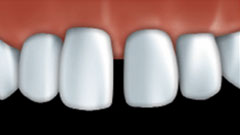
Veneers can be used to fill in gaps.

The custom-made porcelain veneers are glued to your teeth on by one with composite resin cement.
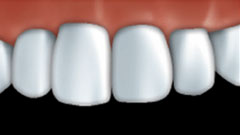
Veneers look very much like natural teeth.
